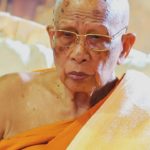Vipassana, insight meditation, is a traditional Buddhist meditation technique developing mindfulness. The goal is better understanding of oneself. The word vipassanā (from the Pali language) means “seeing distinctly”.
Vipassana weakens and removes habitual patterns of behaviour, thought and perception — such as self-criticism, anger, obsessive thinking, worry, anxiety, depression, doubts, feeling of hopelessness and sadness.
Vipassana leads to overall stress reduction, a better understanding of oneself, the ability to deal with difficult emotions and thoughts and appropriate responding to life situations. It brings about not only understanding of oneself, but also of others and thus improves interpersonal relationships.
Vipassana, also called mindfulness meditation, has a wide range of scientifically proven effects on well-being: physical, mental and social (see this summary).
History
The Buddha taught Vipassana as a “direct path for the purification of beings, for the overcoming of sorrow & lamentation, for the disappearance of pain & distress, for the attainment of the right method, & for the realization of Unbinding” (Mahā Satipatthāna-sutta, English translation). Vipassana has flourished since 19th and especially in 20th and 21st centuries; one of the key figures of its development was burmese teacher Mahasi Sayadaw (1904−1982).
Ajahn Tong
 Ajahn Tong (born 1923-2019) was a Thai monk, disciple of Mahasi Sayadaw. Since 1991, he had been abbot of Chom Tong monastery (Chiang Mai province, Thailand) and was one of the most respected Vipassana teachers in southeast Asia. All teachers on our courses are (direct or indirect) students of Ajahn Tong and teach according to his style. Simple walking and sitting exercises cultivate mindfulness, i.e. the awareness of what is happening in the mind in the present moment. Students meet their teacher individually every day for discussion of their practice.
Ajahn Tong (born 1923-2019) was a Thai monk, disciple of Mahasi Sayadaw. Since 1991, he had been abbot of Chom Tong monastery (Chiang Mai province, Thailand) and was one of the most respected Vipassana teachers in southeast Asia. All teachers on our courses are (direct or indirect) students of Ajahn Tong and teach according to his style. Simple walking and sitting exercises cultivate mindfulness, i.e. the awareness of what is happening in the mind in the present moment. Students meet their teacher individually every day for discussion of their practice.
Course formats
In this tradition, the first “basic course” (also called “foundational”) takes 2−3 weeks. Once the basic course is completed, one can do 10-day retreats; the duration is again somewhat flexible, it can take 6−10 days.
With some experience in regular 10-day retreats, it is possible to do “home retreat” (or “daily retreat”) when the student does some meditation on his own every day (1 hour or more), reports regularly to the teacher over phone and only does last 2−3 days of intense meditation in a meditation center (or, conditions allowing, at home).
Other centers
There are a few centers around which offer the same courses; the following map only shows centers in Europe (plus the head center in Chom Tong, Thailand). Continuously-open centers (yellow in the map) can welcome students anytime (consult details on their websites). Groups (in purple) organize courses with fixed days or regular meditation groups.